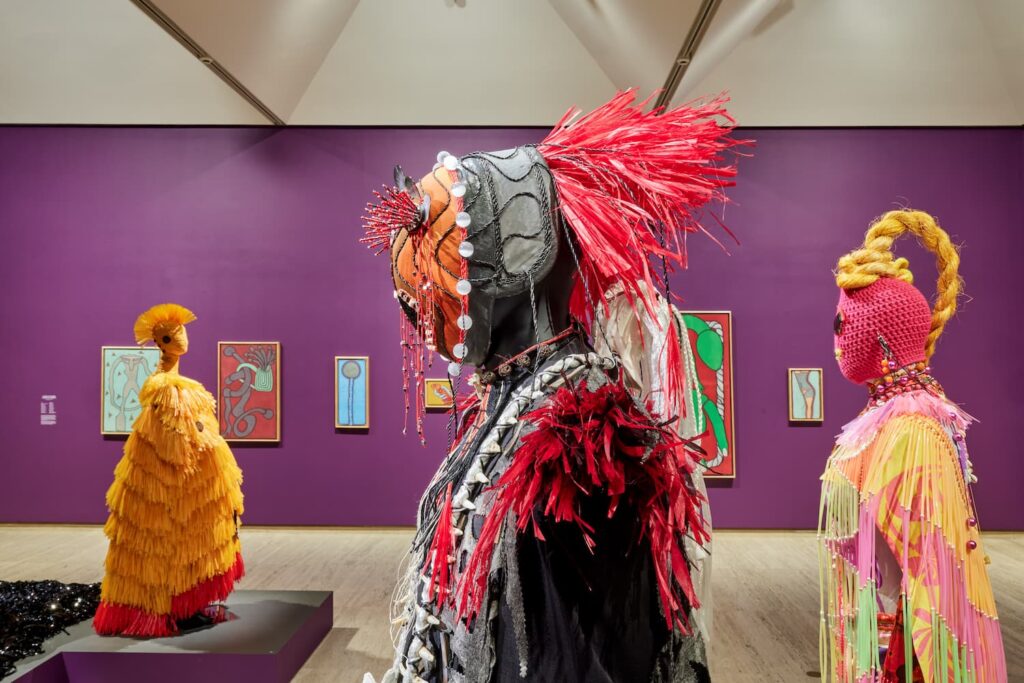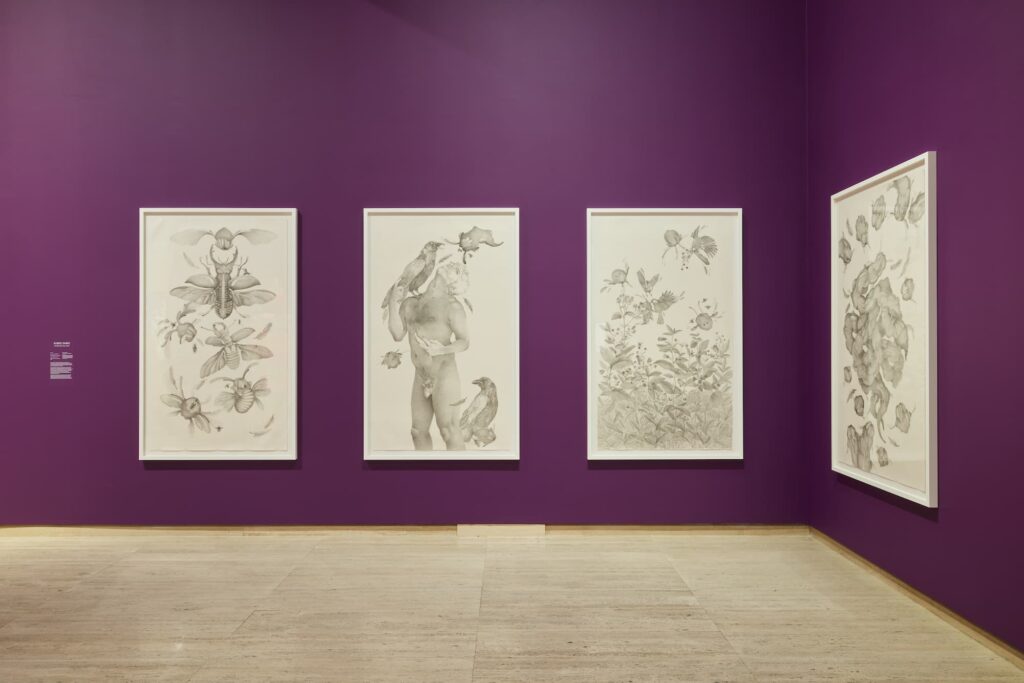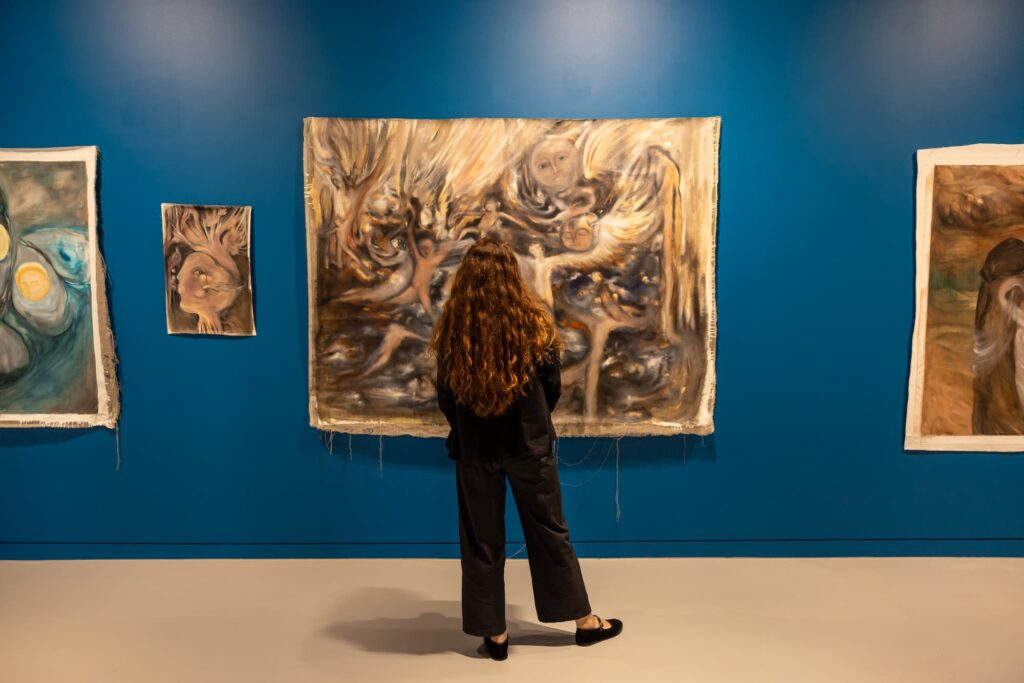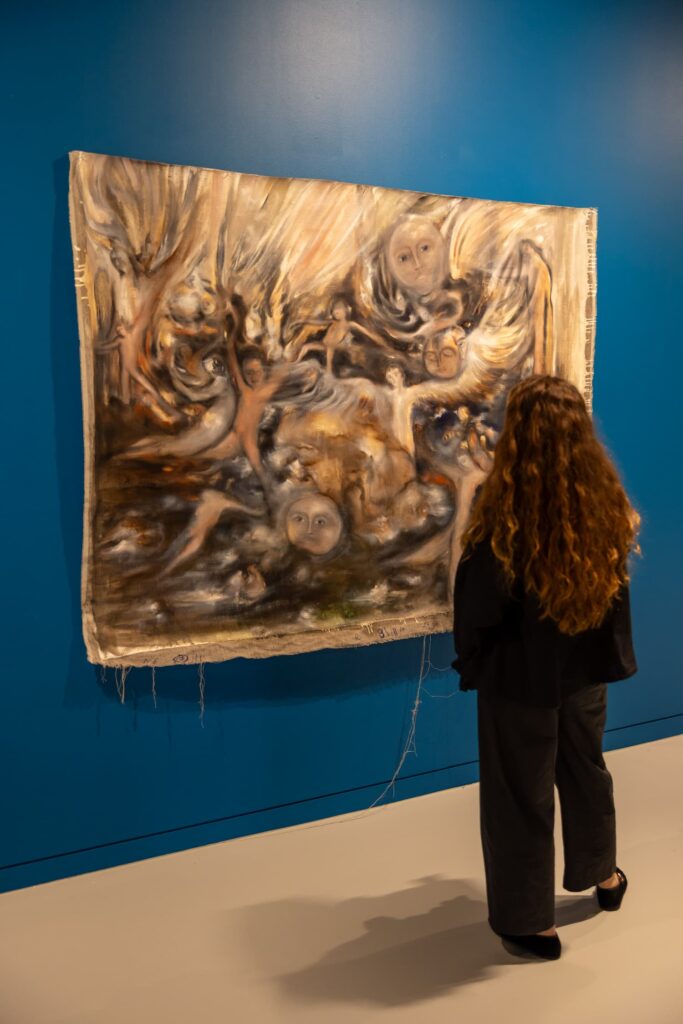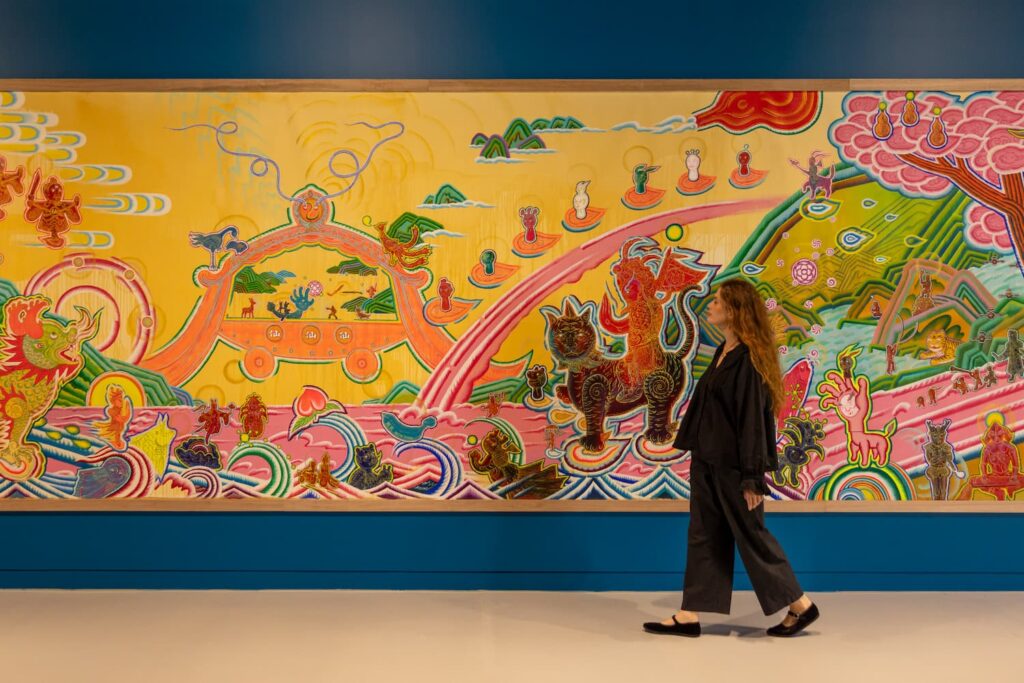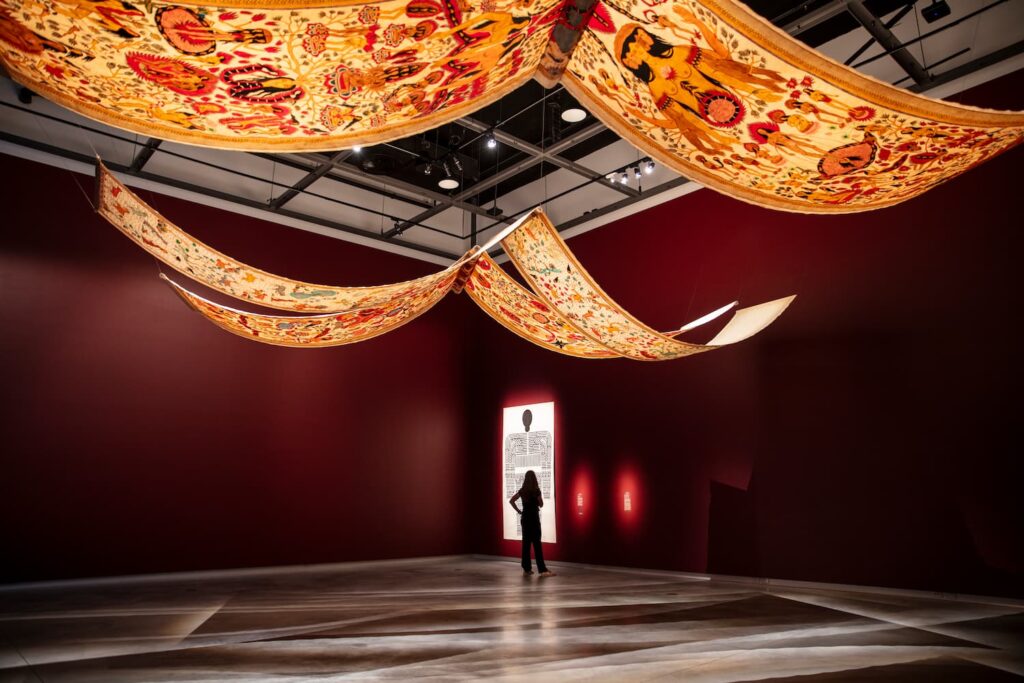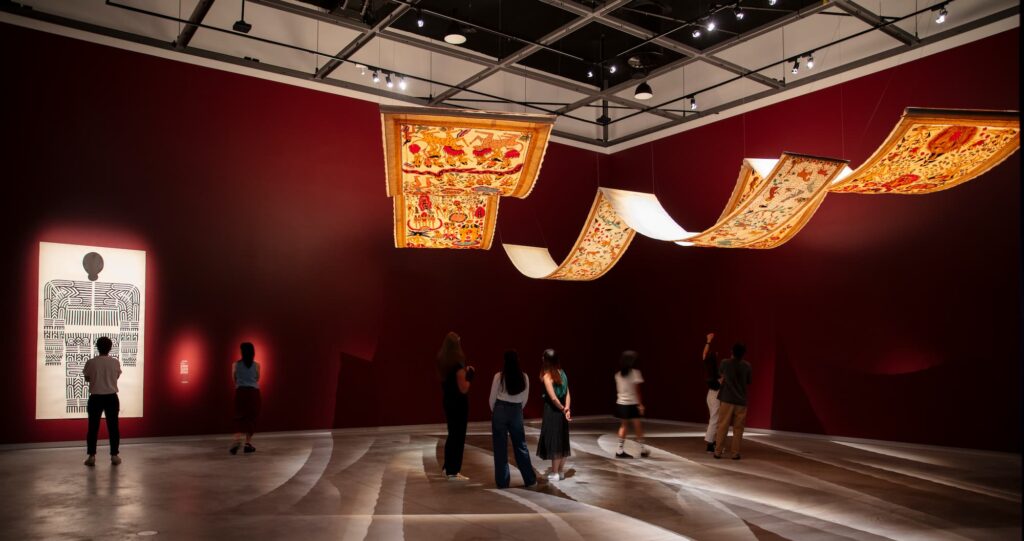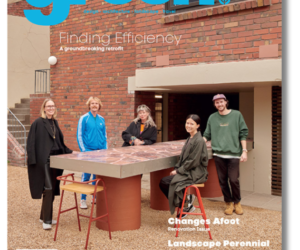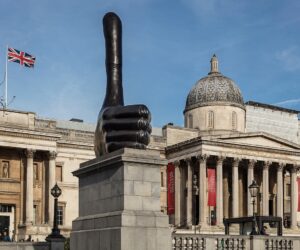The 24th Biennale of Sydney, Ten Thousand Suns, Is Now Open to the Public
The 24th Biennale of Sydney, titled Ten Thousand Suns, has opened to the public. Over 400 artworks by 96 artists and collectives, alongside a dynamic public program, are presented across the city from now until 10 June 2024.
A major international art festival and the largest contemporary art event of its kind in Australia, the 24th Biennale of Sydney is presented at Art Gallery of New South Wales, Artspace, Chau Chak Wing Museum at the University of Sydney, Museum of Contemporary Art Australia, Sydney Opera House, UNSW Galleries and at the iconic and recently restored White Bay Power Station, which has opened its doors to the public for the first time in over 100 years.
With the artistic direction led by Cosmin Costinaș and Inti Guerrero, the 24th Biennale of Sydney proposes celebration as both a method and a source of joy, inspired by legacies of collective resistance and coming together to thrive in the face of injustice. With an exhibition of contemporary art at its core, the event draws from multiple histories, voices and perspectives.
Marking the Biennale of Sydney’s 50th anniversary year, the 2024 edition challenges Western fatalistic constructions of the apocalypse and embraces a hopeful outlook around a possible future lived in joy, produced in common and shared widely.
Audiences can experience dynamic artworks, large-scale installations and site-specific projects by international artists such as Frank Bowling, Andrew Thomas Huang, Adebunmi Gbadebo, Pacific Sisters, Trevor Yeung, Sana Shahmuradova Tanska, Maru Yacco and Anne Samat, alongside Australian artists including Gordon Hookey, Tracey Moffatt & Gary Hillberg, Serwah Attafuah, William Yang, VNS Matrix, Kirtika Kain, Joel Sherwood Spring and Juan Davila.
As a Visionary Partner, the Fondation Cartier pour l’art contemporain has worked with the Biennale of Sydney to commission 14 First Nations artists, including (but not exclusively) Aboriginal and Torres Strait Islander people, to create new work for the edition. These artists include Mangala Bai Maravi, Doreen Chapman, Megan Cope, Cristina Flores Pescorán, Freddy Mamani, Gail Mabo, Dylan Mooney, Orquídeas Barrileteras, John Pule, Eric-Paul Riege, Darrell Sibosado, Kaylene Whiskey, Yangamini, and Nikau Hindin in collaboration with Ebonie Fifita-Laufilitoga-Maka, Hina Puamohala Kneubuhl, Hinatea Colombani, Kesaia Biuvanua and Rongomai Grbric-Hoskins. They have worked closely with the inaugural Fondation Cartier pour l’art contemporain First Nations Curatorial Fellow Tony Albert to realise their artworks. This is part of the ongoing partnership between the Fondation Cartier pour l’art contemporain and the Biennale of Sydney, which also includes a creative collaboration with the Sydney Opera House for the recently launched Badu Gili: Celestial.
Artistic Directors Cosmin Costinaș and Inti Guerrero said: “Ten Thousand Suns departs from an acknowledgement of a multiplicity of perspectives, cosmologies, and ways of life that have always woven together the world under the sun. A multiplicity of suns conveys ambiguous images. It evokes a scorching world, both in several cosmological visions and very much in our moment of climate emergency. But it also conveys the joy of cultural multiplicities affirmed, of First Nations understandings of the cosmos brought to the fore, and of carnivals as forms of resistance in contexts that have surpassed colonial oppression.
“The 24th Biennale of Sydney works with these different layers of meaning, acknowledging the deep ecological crises derived from colonial and capitalist exploitation while refusing to concede to an apocalyptic vision of the future. The 24th Biennale of Sydney proposes instead solar and radiant forms of resistance that affirm collective possibilities around a future that is not only possible, but necessary to be lived in joy and plenitude,” said Costinaș and Guerrero.
ARTWORKS FOR TEN THOUSAND SUNS INCLUDE:
- A major new commission by Yankunytjatjara artist Kaylene Whiskey, known for her uniquely joyful body of work, inspired by pop culture alongside the ‘dot’ iconography of the Central Desert. Titled Kaylene TV, this is the first of Whiskey’s works produced on such an immense scale, inviting audiences into a giant TV with human-size cut-outs of icons such as singers Cher and Dolly Parton, as well as Whiskey’s own hybrid Black superheroes. At a time when all screens seem to be overflowing with stories of crisis, corruption and chaos, Whiskey’s insight into her own sparkling world, lived proudly on Country, makes space for a playfulness and spirit that disavows narratives of inevitable demise. (White Bay Power Station)
- The foyer wall of the Museum of Contemporary Art Australia is transformed with a new commission created by Iraqi-Swedish-American artist of Kurdish descent Hayv Kahraman. Drawing parallels between water, migration, and the processes of Ebru marbling, the artist’s new work explores the violence and vulnerability experienced by undocumented migrants travelling to Australia via sea. (Museum of Contemporary Art Australia)
- Artist Dylan Mooney, a Yuwi, Torres Strait and South Sea Islander man, is known for his high-impact illustrative style with bright, saturated colour, creating works influenced by history, culture and family. His new large-scale mural celebrates the life of the late queer, First Nations dancer and activist Malcolm Cole, who led the first Aboriginal float at the 1988 Sydney Gay and Lesbian Mardi Gras Parade. Through this new commission, Mooney commemorates Cole’s life and activism in the queer and Aboriginal communities. (White Bay Power Station)
- A new drawings series by Roma artist Robert Gabris creates a ‘Garden of Catastrophe’ in an expression of empowerment and agency. The works react against a European anthropological gaze that formed part of the objectification and discrimination faced by Roma people throughout Europe to this day. In intricate graphite detail, the drawings depict a fragmented queer Roma body flourishing and thriving as plants reaching towards the sun. The insects that populate the garden symbolize ancestral wisdom, encoded in their behaviours and cycles of life. (Art Gallery of New South Wales)
- American Chinese artist and Grammy nominated music video director, Andrew Thomas Huang, known for collaborating with artists including FKA Twigs, Bjork and Thom Yorke, presents his first ever sculptural work for the Biennale of Sydney. A great tiger is suspended in the Turbine Hall, wearing a mask referencing Xiwangmu (西王母), Queen Mother of the West in Chinese mythology. Crowned with her messenger birds, qingniao (青鳥), the work complicates not only the boundaries between male and female, but between the human and the non-human, the real and the imagined. (White Bay Power Station)
- Peruvian artist Cristina Flores Pescorán has created a new large-scale textile sculpture inspired by her own healing journey from a skin cancer condition, which exposed her to invasive examinations, biopsies, surgical interventions, and medical observation for almost two decades. Dedicating a lifetime to healing her illness and investigating alternatives to Western medical interventions, the artist imagines a cure not as treatment but as a dialogue between body and ancestry, rooted in the restorative processes of nature. Made with Peruvian cotton thread dyed with purple corn (maíz morado), a Peruvian food that accompanied the artist during her treatments, Abrazar el sol (Embrace the sun) is a reconciliation between woman and sun. (White Bay Power Station)
- Orquídeas Barrileteras (Orchid Kite), the first all-female group of kite makers from Guatemala’s Barrilete Festival, consists of 22 women spanning three generations. Stretching five meters wide, their lovingly and intricately designed kites are handmade using cloth, paper, bamboo, tissue, string, and natural materials. Sharing familial stories, cultural themes and many emotions through pattern and bright colours, their kites are flown in a celebration of life and of those who lived. For the Biennale of Sydney, the collective has created a large-scale textile kite with two women from their community who are deaf in the centre. The work pays homage to these women showing appreciation for their unique and valuable input to their visual arts practice as well as the broader community, surrounded by flowers and animals native to Guatemala. (White Bay Power Station)
- Citra Sasmita began researching the patriarchal roots of modern Bali by looking to the literary and artistic canon of Indonesia, which broadly narrates male heroism and depicts women as romantic decorations. Through her Timur Merah Project, Sasmita creates counter-narratives that depict women as powerful and resistant actors who push back against a male gaze informed by colonial ideology. Sasmita uses traditional Kamasan painting to reclaim the female figure as an active de-colonial agent challenging the exotic aesthetic heritage of Baliseering. (Chau Chak Wing Museum at the University of Sydney)
- A series of paintings and graphics created by Ukrainian artist Sana Shahmuradova Tanska, based in Kyiv and created in the wake of the invasion of Ukraine in 2022, which sent Shahmuradova Tanska to Cold War shelters plastered with old atomic war posters. Rendered in oil paint and, watercolour, Shahmuradova Tanska draws upon Ukrainian history and folklore for inspiration, blurring the line between form and mirage through dreamy figures that explore a molten landscape of collective memory, grief and violence. (Artspace)
- Trevor Yeung, who has been selected to represent Hong Kong at the upcoming Venice Biennale, uses his sculptures as cyphers for his own emotional reality. A metaphor for interpersonal connections, Yeung’s mushroom lights are a study in the constraints, care and conditions necessitated to support ecosystems and, symbolically, relationships. Each ‘chandelier’ exists on a closed-circuit system which, despite appearing to tumble organically, is entirely fabricated and closed off. Reminiscent of a child’s night light, a symbol of both security and naivety, these installations reflect Yeung’s sense of being a social interloper. (Artspace and White Bay Power Station)
- Tāgata Moana art collective Pacific Sisters, a collective of Pacific and Māori fashion designers, artists, performers, and musicians present Mururoa, addressing the effects of nuclear testing in the wider Pacific and its long-term damaging environmental and physical impacts on Moana peoples and Supa Suga, described as ‘part Wonder Woman’ and part Superman, and ‘all girl power’. The collective emerged from the fringes of mainstream arts and culture in Aotearoa New Zealand in 1991 and are celebrated for their multi-disciplinary practice that blends Moana heritage art and contemporary forms to create fashion activism. Through ceremony, art, adornment and performance, they embrace and assert their urban Māori, Pacific, and Queer identities, unique to Aotearoa New Zealand. The collective includes Rosanna Raymond, Feeonaa Clifton, Ani O’Neill, Suzanne Tamaki, Henry Ah-Foo Taripo, Lisa Reihana and more. (Art Gallery of New South Wales)
- Big Chief Demond Melancon is part of a more than 200-year-old culture known as the Black Masking Culture of New Orleans, which endures as a thriving display of dance, spirituality, craftsmanship and pride. On Mardi Gras morning, Black Maskers emerge from their homes to the beating of drums and tambourines to parade their way through the streets to confront each other in ceremonial battles to see who is the prettiest, wearing intricately beaded suits. Part of a suit worn by the artist for the Mardi Gras parade, Big Chief Demond Melancon’s Africa depicts Zulu warriors drawing connections between African and First Nations traditions. (Art Gallery of New South Wales)
- Acclaimed artist Frank Bowling’s Australia to Africa, part of his seminal ‘Map Painting’ series, merges postcolonial geopolitics with abstraction. Bowling is known for layering canvases with stained or washed colours so they appear flooded with light, creating luminous, near-illusory cartographies. In the monumental Australia to Africa, the outline of Australia, Africa, Europe, Asia, and the even fainter impression of America, swim in an ocean of gold. By refusing to divorce abstraction from content, Bowling’s work intersects with his own Afro-Caribbean roots, unfurling with the hallucinatory intensity of a dream. (Art Gallery of New South Wales)
- Sydney-based multidisciplinary artist and musician Serwah Attafuah, who has previously collaborated with artists including Charli XCX and Paris Hilton, is known for her practice exploring surreal cyber dreamscapes and heavenly wastelands. For the 24th Biennale of Sydney, Attafuah’s digital creation unfolds in a near-future Ghana, drawing viewers into an Afrofuturistic vista contrasting colonial remnants with utopian hope, with a narrative that is propelled by burning slave castles, sinking colonial ships, and formidable female warriors. Her avant-garde blend of cultural reflections with futuristic aesthetics is a compelling discourse between past legacies and speculative horizons. (Museum of Contemporary Art Australia)
- Quandamooka (Minjerribah, North Stradbroke Island, Queensland) artist Megan Cope confronts social, geographical, and metaphorical boundaries through military-style maps that contest the myth of terra nullius. Cope replaces colonial titles with those of her Jandai language. Made from hand-drawn and photo-lithographic processes, each map, glowing with crystalline blue tides, returns cultural names and landmarks to their rightful place in an act of decolonial cartography. (UNSW Galleries)
- Transcending tradition, Malaysian artist Anne Samat works with established fibre and weaving techniques from across Southeast Asia, to build elaborate woven totems as monuments to family lineages, mythologies and as mouthpieces for her message of love. Her sculptures are modelled from the artist’s real-life relationships with friends or family and form sites of personal devotion and care. For the 24th Biennale of Sydney Samat has created a new commission, Cannot Be Broken and Won’t Live Unspoken #2, that combines traditional crafts with humble and everyday objects. (Museum of Contemporary Art Australia)
- Diné (Navajo) artist Eric-Paul Riege uses a combination of natural and synthetic materials, including wool, cotton, shells, faux fur, and human hair, to create his signature woven sculptures. Riege continues the Indigenous weaving and jewellery-making traditions inherited within his own family history. For the Biennale of Sydney, the artist presents a major sculptural installation, as well as a series of new works reflecting on the Diné philosophy of hózhó which encompasses the values of beauty, balance, and goodness in all things physical and spiritual. (Artspace and White Bay Power Station)
- Mangala Bai Maravi, an artist from the Baiga group in India, works to preserve the traditional tattooing patterns of her people by documenting them through her art. The women in the community are tattooed at various stages throughout their life, a tradition passed down through generations where designs are made entirely from memory and oral history. (Chau Chak Wing Museum and White Bay Arts Precinct)
- Delhi-born, Sydney-based artist, Kirtika Kain examines how oppressive social hierarchies and power structures have been enforced upon and embodied by generations before her from the perspective of an outsider. The Biennale of Sydney has commissioned Kain to create a ten-metre-long layered canvas, working with materials including cow dung, gold leaf and wax. (Museum of Contemporary Art Australia)
- Māori artist Nikau Hindin presents multiple works at different locations for the Biennale, featuring the aute (bark cloth) she paints with the maps, calendars, and motifs of her culture. Unlike other bark lineages across Te Moana Nui a Kiwa (The Great Ocean), the Māori bark cloth technique that Hindin employs was last practised in Aotearoa more than a century ago, when the paper mulberry tree that is the main source of bark was almost made extinct. (White Bay Power Station, UNSW Galleries and Sydney Opera House)
- Dhopiya Yunupiŋu’s works depict the history of First Nations people’s trade relations with the Bugis and Makassar merchants who would travel from today’s Indonesia to the territory in search of trepang (sea cucumber). Based on the stories passed down through songlines, Yunupiŋu employs traditional cross-hatching (miny’tji, in North East Arnhem Land) to depict agricultural, familial and trade scenes that illuminate a history little known to the wider Australian community. (UNSW Galleries)
A dynamic public program will be presented alongside the artworks, which kicked off with the opening night concert Lights On at White Bay Power Station on 8 March 2024. During opening weekend, free performances and art activations took place, including Spotlight Artist Talks where artists present alongside their works, as well as performances by exhibiting artists including Eric-Paul Riege and Cristina Flores Pescorán.
Throughout the three-month exhibition there will be daily art tours, plus dedicated student workshops, three family days curated by disability arts organisations and practitioners, and regular Wednesday evening contemporary music nights curated by Phoenix Central Park that are ticketed through a ballot system. Other program highlights include a new commission by performance artist Tommy Misa titled Working Class Clown inspired by the Samoan political satire tradition of Fale Aitu and the iconoclastic drag scene of Sydney’s yesteryear, as well as the return of the hugely popular cult performance night Queer PowerPoint.
The list of artists as part of the 24th Biennale of Sydney (2024) are:
Art Gallery of New South Wales
- Big Chief Demond Melancon (USA)
- Bonita Ely (Australia)
- Breda Lynch (Ireland)
- Doreen Chapman (Manyjilyjarra, Australia)
- Eisa Jocson (Philippines)
- Francisco Toledo (Mexico)
- Frank Bowling (UK / Guyana)
- Gordon Hookey (Waanyi, Australia)
- I Gusti Ayu Kadek Murniasih (Murni) (Indonesia)
- Iratxe Jaio & Klaas van Gorkum (Basque Country / Spain/ Netherlands)
- James Eseli (Kala Lagaw Ya/Badhulaig, Torres Strait Islands, Australia)
- John Pule (Niue / Aotearoa New Zealand)
- Magdalena Meak (Lia Na’in, Indonesia)
- Maru Yacco (Japan)
- Ming Wong (Singapore / Germany)
- Nádia Taquary (Brazil)
- Pacific Sisters (Aotearoa New Zealand)
- Pauletta Kerinauia (Miyartuwi (Pandanus), Tiwi Islands, Australia)
- Pauline Yearbury (Ngāpuhi/Māori, Aotearoa New Zealand)
- Robert Gabris (Slovakia / Austria)
- Rotimi Fani-Kayode (Nigeria / UK)
- Rover Joolama Thomas (Kukatja/Wangkajunga, Australia)
- Sachiko Kazama (Japan)
- Saule Dyussenbina (Kazakhstan)
- Weaver Hawkins (England / Australia)
Artspace
- Adebunmi Gbadebo (USA)
- Doreen Chapman (Manyjilyjarra, Australia)
- Eric-Paul Riege (Diné/Navajo, USA)
- Li Jiun-Yang (Taiwan)
- r e a (Gamilaraay/Wailwan/Biripi, Australia)
- Sana Shahmuradova Tanska (Ukraine)
- Trevor Yeung (China / Hong Kong)
Chau Chak Wing Museum at the University of Sydney
- Carrolup Child Artists: Arthur Bropho, Alma Cuttabut, Parnell Dempster, Phillip Jackson, Gregory Kelly, Edie Wallam, and five once known child artists (Australia)
- Choy Ka Fai (Singapore / Germany)
- Citra Sasmita (Indonesia)
- Diane Burns (Anishinaabe/Chemehuevi, USA)
- Doreen Chapman (Manyjilyjarra, Australia)
- Juan Davila (Chile / Australia)
- Mangala Bai Maravi (India)
- Martin Wong (USA)
- Niño de Elche & Pedro G. Romero (Spain)
- William Yang (Australia)
Museum of Contemporary Art Australia
- Anne Samat (Malaysia / USA)
- Doreen Chapman (Manyjilyjarra, Australia)
- Frank Moore (USA)
- Freddy Mamani (The Plurinational State of Bolivia)
- Hayv Kahraman (Iraq / Sweden / USA)
- Irene Chou (China / Australia)
- Juan Davila (Chile / Australia)
- Kirtika Kain (India / Australia)
- Robert Campbell Jnr (Ngaku/Dunghutti, Australia)
- Segar Passi (Meriam Mir/Dauareb, Torres Strait Islands, Australia)
- Sergey Parajanov (Armenia / Georgia)
- Serwah Attafuah (Ashanti, Australia)
- Te Whā a Huna (Tūwharetoa, Aotearoa New Zealand)
- Tracey Moffatt & Gary Hillberg (Australia)
- William Strutt (UK)
UNSW Galleries
- Agnieszka Kurant (Poland / USA)
- Agnieszka Polska (Poland / Germany)
- Bonita Ely (Australia)
- Candice Lin (USA)
- Christopher Pease (Minang/Wardandi/Bibbulmun, Australia)
- Dhopiya Yunupiŋu (Gumatj/Yolŋu nation, Australia)
- Doreen Chapman (Manyjilyjarra, Australia)
- Elyas Alavi (Hazara, Afghanistan / Australia) with Hussein Shirzard (Afghanistan / Australia); Jim Hinton (Australia); John Hinton (Australia); and Alibaba Awrang (Afghanistan / USA)
- Idas Losin (Truku/Atayal, Taiwan)
- Joel Sherwood Spring (Wiradjuri, Australia)
- Júlia Côta & Prazeres Côta (Portugal)
- Köken Ergun (Turkey / Germany)
- Kubra Khademi (Afghanistan / France)
- Leila el Rayes (Australia)
- Mauroof Jameel & Hamsha Hussain (Maldives)
- Megan Cope (Ngugi/Noonuccal, Quandamooka, Australia)
- Nikau Hindin (Te Rarawa/Ngāpuhi, Aotearoa New Zealand)
- Simon Soon (Malaysia)
- Udeido Collective (West Papua)
- Wendy Hubert (Guruma/Yindjibarndi, Australia)
- William Yang (Australia)
- Yangamini (Tiwi; Gulumirrgin; Warlpiri; Kunwinjku; Yolŋu; Wardaman; Karajarri; Gurindji; Burarra, Australia)
White Bay Power Station
- Agnieszka Polska (Poland / Germany)
- Alberto Pitta (Brazil)
- Andrew Thomas Huang (USA)
- Barrileteros Almas del Viento (Guatemala)
- Chitra Ganesh (USA)
- Christopher Myers (USA)
- Cristina Flores Pescorán (Perú / Netherlands / USA)
- Darrell Sibosado (Bard/Noongar, Australia)
- Doreen Chapman (Manyjilyjarra, Australia)
- Dr. Destiny Deacon (KuKu (Cape York) & Erub/Mer (Torres Strait), Australia)
- Dumb Type (Japan)
- Dylan Mooney (Yuwi/Meriam Mir/South Sea Islander, Australia)
- El Gran Mono (Colombia / Australia)
- Eric-Paul Riege (Diné/Navajo, USA)
- Felix de Rooy (Curaçao / Netherlands)
- Joel Sherwood Spring (Wiradjuri, Australia)
- Josh Kline (USA)
- Kaylene Whiskey (Yankunytjatjara, Australia)
- Lawrence Lek (Malaysia / UK)
- Mangala Bai Maravi (India)
- Mariana Castillo Deball (Mexico / Germany)
- Marie-Claire Messouma Manlanbien (France)
- Monira Al Qadiri (Kuwait / Germany)
- Nikau Hindin (Te Rarawa/Ngāpuhi, Aotearoa New Zealand), Ebonie Fifita-Laufilitoga-Maka (Fungamapitoa, Tonga, Aotearoa New Zealand), Hina Puamohala Kneubuhl (Kihalaupoe, Maui, Hawai‘i), Hinatea Colombani (Arioi, Tahiti), Kesaia Biuvanua (Moce, Lau, Fiji), Rongomai Grbric-Hoskins (Te Rarawa/Ngāpuhi, Aotearoa New Zealand)
- Orquídeas Barrileteras (Guatemala)
- Özgür Kar (Turkey / Netherlands)
- Peter Minshall (Guyana / Trinidad & Tobago)
- Petrit Halilaj (Kosovo / Germany) & Álvaro Urbano (Spain / Germany)
- Satch Hoyt (UK / Jamaica)
- Trevor Yeung (China / Hong Kong)
- VNS Matrix (Australia)
- William Yang (Australia)
Key Dates
8 March 2024 – Lights On opening night, White Bay Power Station
6-8 March 2024 – Vernissage (Professional Preview)
9 March – 10 June 2024 – Biennale of Sydney open to the public
Admission is free.
For further information on the Biennale of Sydney, please visit biennaleofsydney.art.
For the 24th Biennale of Sydney at White Bay Power Station, designated 443 buses will be running from Sydney’s CBD to White Bay Power Station, alongside the regular bus routes 441 or 442.
